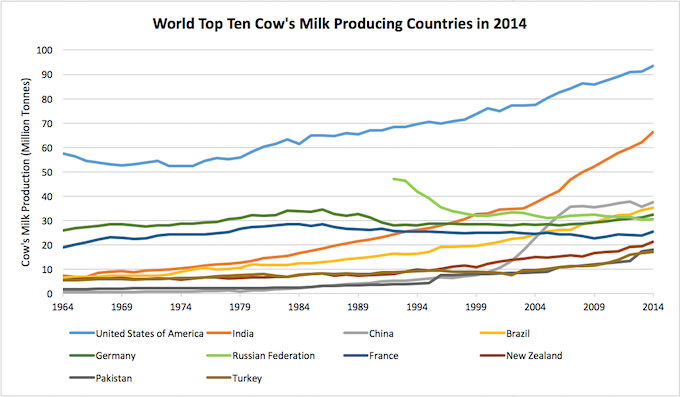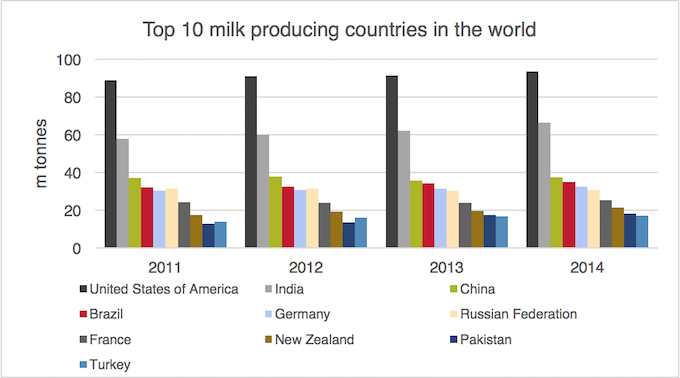What Are The Top Cow’s Milk Producing Countries In The World ?
View the evolution of cows’ milk production per year around the world.
FAO data shows:
- World cow’s milk production in 2014 stood at 656 million tonnes.
- The USA was the largest cow’s milk producer in the world in 2014 and India is the second largest cow’s milk producer.
- All of the top ten largest milk producing countries saw growth in production between 2013 and 2014. Of these, New Zealand had the largest percentage growth, up 9.5% on the year.

10. UK
In the United Kingdom, dairy cows there are bred specifically to produce milk in large quantities. The country is the 10th topmost producer of cow’s milk globally, and the third largest one in the European Union, falling behind only Germany and France.
9. Turkey
Dairy farms are relatively smaller in Turkey than in much of the rest of the world. Turkish cows’ milk production has witnessed a boost within the last few years. The country mainly exports milk to the European Union, though the Turkish government has taken several steps to boost the demand for cow’s milk in the domestic market as well.
8. New Zealand
The island country has approximately 5 million dairy cows. The country mainly exports milk-derived products like milk powder, butter, cheese, and cream to other countries across the world..
7. France
It is Europe’s second largest producer of cow milk. It has more than 3.6 million dairy cows, and a wide variety of cows’ milk processing facilities. Most of the produced milk is converted into milk products like cheese and milk powder. France mainly exports the parts of its milk products not consumed domestically to Italy and Germany.
6. Russia
Currently, the country is investing substantially in developing better yielding breeds. Russian investors’ are also investing to build the largest dairy farm in China to meet its increasing domestic demand for cows’ milk.
5. Germany
With more than 4.2 million dairy cows, Germany is at the top of the milk producers in the European Union. There is a large difference in herd sizes in the country. Eastern and Western Germany alike account for significant proportions of the German cows’ milk production.
4. Brazil
Despite being a large net importer of dairy products in the past, the country has become one of the top cows’ milk producing countries. The dairy sector in Brazil has a strong Indian connection, as they have a large number of pure-breed ‘Gir’ cows that are native to Gujarat, India, and these are famous for producing large quantities of milk. The cows’ milk production gives an employment to nearly one million people in Brazil.
3. China
The Asian country is a world leader in terms of cows’ milk production. The country is now heavily investing in building a 100,000-cow dairy farm to export milk to Russia, as Russia has decided to largely stop its milk imports from the countries of the European Union.
2. India
Today, India contributes a whopping 9.5 percent of the global cows’ milk production. An approximate 80 percent of the production comes from an unorganized sector of small farmers. The country has more than 130,000 dairy cooperative societies at the village level. The country is also the largest milk consumer. It also exports milk to many countries.
1. USA
The country is at number one in cows’ milk production, as in India a significant portion of milk production comes from buffaloes. Many of the larger dairy farms in the US have more than 15,000 cows each. However, many small farms with less than 30 cows each also contribute significantly to the overall cows’ milk production. Besides a massive domestic demand for cheese, milk, and other dairy products, the country also exports its cow milk and its milk products in large quantities to a large number of other countries all around the world as well.

[Sources : dairy.ahdb.org.uk – worldatlas.com]
Unisensor improves food safety with screening solutions to detect antibiotics in dairy and food processing industries. We offer one of the broadest range of tests to detect a large number of antibiotics used in the agro-food industry.




